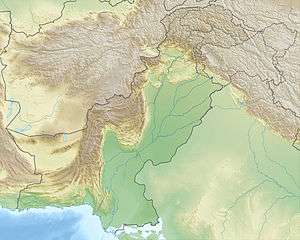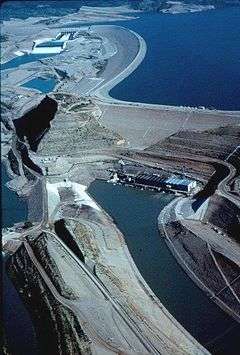Dasu Dam
The Dasu Dam is a large hydroelectric gravity dam currently under construction on the Indus River near Dasu in Kohistan District, Khyber Pakhtunkhwa Province, Pakistan. It is developed by Pakistan Water and Power Development Authority (Wapda), as a key component of the company's Water Vision 2025.
| Dasu Dam | |
|---|---|
 Location of Dasu Dam in Pakistan | |
| Country | Pakistan |
| Location | Dasu, Kohistan District, Khyber Pakhtunkhwa Province |
| Coordinates | 35°19′02.16″N 73°11′35.78″E |
| Purpose | Power, water supply |
| Status | Under construction |
| Construction began | June 2017 |
| Opening date | 2025 (est.) |
| Construction cost | $4.278 billion (stage I) |
| Owner(s) | Government of Pakistan |
| Operator(s) | Water and Power Development Authority (WAPDA) |
| Dam and spillways | |
| Type of dam | Gravity, roller-compacted concrete |
| Impounds | Indus River |
| Height | 242 m (794 ft) |
| Length | 570 m (1,870 ft) |
| Reservoir | |
| Total capacity | 1,410,000,000 m3 (1,140,000 acre⋅ft) |
| Dasu Hydropower Plant | |
| Coordinates | 35°17′47.03″N 73°12′44.59″E |
| Commission date | Early 2025 (stage I) |
| Hydraulic head | 171.59 m (563.0 ft) |
| Turbines | Stage I: 6 x 360 MW Francis-type Stage II: 6 x 360 MW Francis-type |
| Installed capacity | 4,320 MW |
| Annual generation | 21 TWh |
The 242 m (794 ft) tall dam will support a 4,320 MW hydropower station, to be built in two 2,160 MW stages. The plant is expected to start generating power in late 2024, and stage I is planned to complete by early 2025.[1]
Water from the reservoir will be diverted to the power station located about 3.5 km (2.2 mi) downstream.[2]
Timeline
Dasu dam proposal was approved in 2001, as part of Government of Pakistan’s Vision 2025 program. Feasibility study was completed in 2009.[3]
The first stage was approved by the Executive Committee of the National Economic Council on 29 March 2014. It will cost an estimated $4.278 billion.[4] Former Prime Minister Nawaz Sharif attended the dam's groundbreaking ceremony on 25 June 2014.[5]
Contracts for preparatory works of the project were awarded in the first half of 2015, and early construction works actually started in June 2017.[3]
The main civil works, undertaken by China Gezhouba Group Company Limited, started in February 2018. Work on the water diversion tunnel was inaugurated December 2018.[6]
In November 2019, Wapda signed a first Rs52.5 billion contract with a chinese joint-venture, regarding electro-mechanical works. This contract includes design, supply and installation of the first stage's six 600 MW turbines, along with their generators, and transformers.[7]
As of March 2020, aside from the main civil works on diversion tunnels and powerhouse access, construction of the right bank access road, the relocation of Karakoram Highway, and the 132 kV transmission line was also under way.[1]
Funding
The project cost was revised from an initial Rs486.093 billion to Rs510.980 billion, mainly because of escalation of land cost.[8]
Funding is being provided by the World Bank ($700 million), the Industrial and Commercial Bank of China ($1.5 billion), Deutsche Bank ($1 billion) and Aga Khan Development Network ($500 Million).
On 1st April 2020, World Bank approved an additional $700 million in financing, with the funds to be used for the transmission line that will complete the first 2,160 MW phase of the project on the Indus River.[9]
Resettlement and Shatial Museum
In December 2015, Pakistan Water and Power Development Authority (Wapda) signed a contract worth Rs571.95 million with China Railway First Group for construction at resettlement sites and building the Shatial museum – two schemes that are part of the Dasu hydroelectric power project.
The contract includes construction at three sites for the resettlement of displaced people belonging to Choochang village and developing an open-air museum at the archeological site of Shatial to conserve pre-historic rock carvings. Work on these schemes is expected to be completed in one and a half years.
References
- "Project update: 4,320-MW Dasu hydropower on schedule to begin generation in 2024". Hydro Review. 2020-02-25. Retrieved 2020-04-23.
- "Dasu Hydropower Project". Nippon Koei Co. Retrieved 1 April 2014.
- "Dasu Hydropower Project, Indus River, Kohistan, Pakistan". Retrieved 2020-04-23.
- "Dasu hydropower project: Rs 486 billion approved by Ecnec". Business Recorder. 29 March 2014. Retrieved 1 April 2014.
- "Boosting sales: Dasu dam to cement industry's growth". The Express Tribune. 27 June 2014. Retrieved 29 June 2014.
- https://www.dawn.com/news/1450872
- "Dasu Hydropower Project: Wapda signs Rs52.5 bn contract with China for electro-mechanical work". www.thenews.com.pk. Retrieved 2020-04-23.
- https://www.thenews.com.pk/print/467991-dasu-project-s-revised-cost-recommended-to-ecnec
- https://www.waterpowermagazine.com/news/newsworld-bank-approves-additional-700-million-for-the-dasu-project-pakistan-7851337
